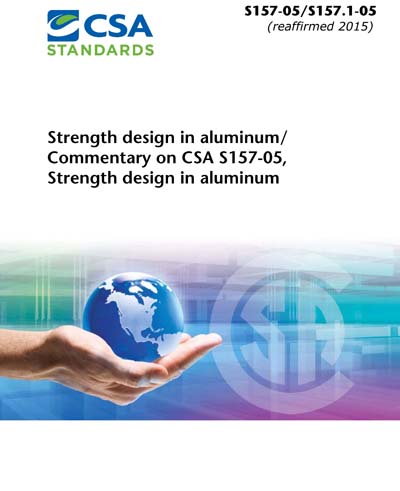Historical
CAN/CSA S157-2005/S157.1-2005 (R2010)
CAN/CSA-S157-05/S157.1-05 (R2010) - Strength Design in Aluminum / Commentary on CSA S157-05, Strength Design in Aluminum
Update #1 was published as notification that this is now a National Standard of Canada.
Intended Use
Continuing research in North America and Europe, and the manner in which this Standard is used, required that important changes be made in the arrangement of the text and the design procedures adopted. The 2005 edition is primarily for applications in buildings but is written in a form that may be used for all types of aluminum load-bearing components or assemblies. Expressions for the strength of structural components are based on the concept of limit states design.
Requirements to satisfy the ultimate limit state form the core of the Standard. As a document referenced by the National Building Code of Canada, the load factors and resistance factors specified by that code are given. However, because the design expressions predict the characteristic resistance of components and
connections, this Standard will be useful in any field of engineering in which known applied loads are to be supported.
A commentary, CSA S157.1, Commentary on CSA Standard S157-05, Strength design in aluminum is included.
Preface
This is the fourth edition of CSA S157, Strength design in aluminum. It supersedes the previous editions published in 1983, 1969, and 1962.1. Scope
1.1 This Standard applies to the design of aluminum alloy members and assemblies intended to carry a known load.1.2 This Standard specifies requirements for the design of members to meet the requirements of the National Building Code of Canada using limit states design procedures.
1.3 This Standard contains rules to determine the ultimate resistance of aluminum members and connections, and may be used for the design of aluminum assemblies in general.
1.4 Where members designed in accordance with this Standard are intended for use in structures for which other standards apply, this Standard supplements such standards, as applicable. Note: Annex A lists some applications to which other standards apply.
1.5 Where this Standard does not provide design expressions or dimensional limitations that are applicable to a specific situation, a rational design may be used, based on appropriate theories, tests, analyses, or engineering experience. Note: See Annex B for common uses of alloys.
1.6 In CSA Standards, "shall" is used to express a requirement, i.e., a provision that the user is obliged to satisfy in order to comply with the standard; "should" is used to express a recommendation or that which is advised but not required; "may" is used to express an option or that which is permissible within the limits of the standard; and "can" is used to express possibility or capability. Notes accompanying clauses do not include requirements or alternative requirements; the purpose of a note accompanying a clause is to separate from the text explanatory or informative material. Notes to tables and figures are considered part of the table or figure and may be written as requirements. Annexes are designated normative (mandatory) or informative (non-mandatory) to define their application.
1.7 The expressions contained herein are dimensionally uniform, and any consistent system of units may be employed. Where dimensions are identified, SI units are used. Evaluation is normally conducted in newtons (N) for force, millimetres (mm) for length, and megapascals (MPa = N/mm2) for stress.
CSA America, Inc. [csa]

